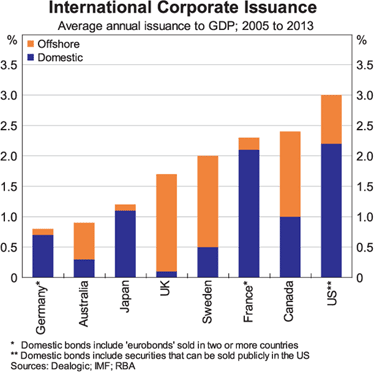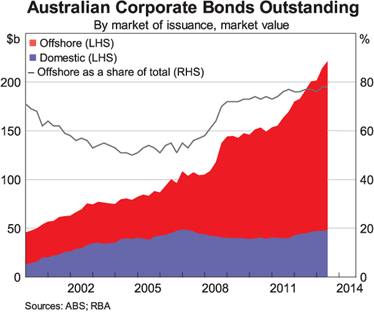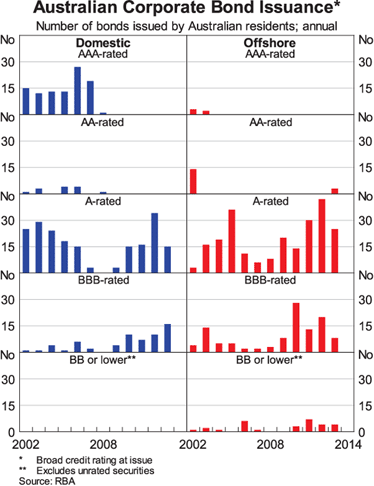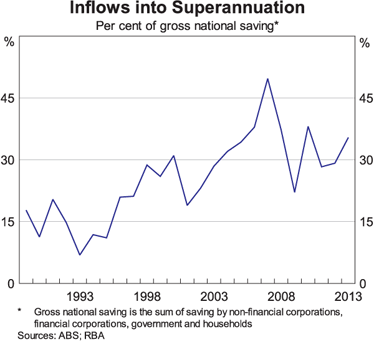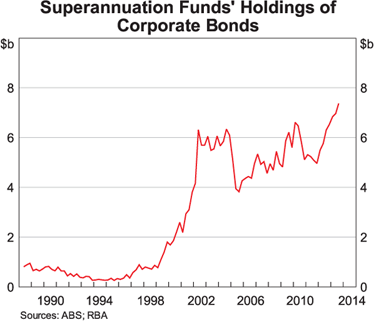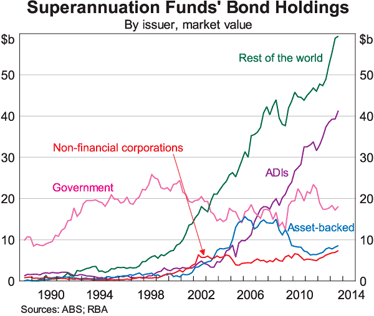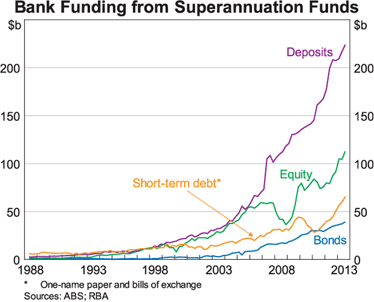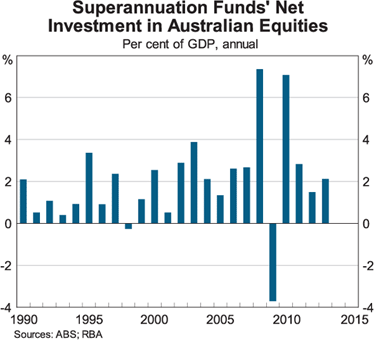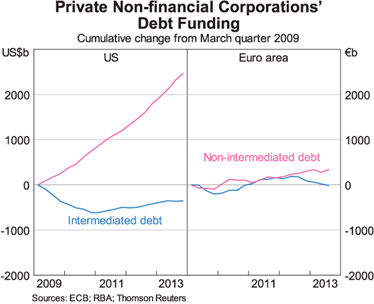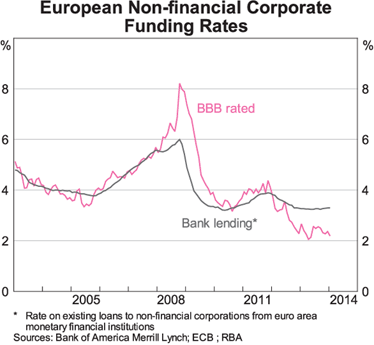
Speech to the ASIC Annual Forum 2014 Sydney - 25 March 2014
When I was invited to speak at this conference, the ASIC organisers suggested the topic ‘Opportunities and Challenges for Market-Based Financing’. I was very pleased to be able to accept the invitation as this topic is an important one. It is currently also a highly relevant topic given the Australian Government's recently commissioned inquiry into the Australian Financial System.
I would like to start with a quote from the final report of the previous inquiry into our financial system – the Wallis Inquiry which handed down its findings 17 years ago. In particular, the report observed:[1]
The evolution of financial systems has been characterised by a continuing struggle between financial intermediaries and financial markets.
While the inquiry was wary about making precise predictions, there was quite a strong sense in the report that financial markets would inevitably win this struggle; that over time, markets – including the bond market – would become increasingly important in connecting savers to borrowers. It was thought likely that improvements in technology and access to information would allow better and more differentiated pricing of risk. And that this, combined with increased household savings in superannuation funds and a shift in investment preferences, would give markets the edge over the traditional financial intermediaries, namely the banks.
While we have seen some steps in this general direction, including the financing of mortgages through residential mortgage-backed securities (RMBS), things have not exactly turned out this way. Improvements in information technology have greatly improved access to information. However, the challenge turned out not to be so much in accessing the information, but in using the information well. It also turned out that households' investment preferences did not change that much and that to the extent that they did change, it was mainly reflected in an increased appetite for equities. As a result, while market-based financing has developed over time, it has not grabbed the upper hand as some had thought likely at the time the Wallis Inquiry delivered its final report.
One area that has attracted considerable attention is the non-financial corporate bond market. Some commentators have lamented the fact that the Australian market has not developed more rapidly, with most business borrowers still connecting with savers over the balance sheets of financial institutions. Some of these commentators have also lamented the fact that superannuation funds – who they see as a natural buyer of corporate bonds – seem to have had only a limited appetite for these bonds.
Given this background, I thought it would be useful to briefly discuss recent developments in the Australian non-financial corporate bond market as well as the role that superannuation funds have come to play in intermediating between borrowers and savers. I would then like to discuss the role that market-based corporate financing can play in providing a form of insurance against stresses in the banking system and the possibility of a lack of competition in the banking system.
The Australian Corporate Bond Market
By international standards, the Australian corporate sector makes relatively little use of the bond market, especially the domestic bond market. Since the mid 2000s, the available internationally comparable data suggest that average annual bond issuance by Australian corporations has been the equivalent of just under 1 per cent of GDP, with around two-thirds of total issuance taking place offshore, rather than in the domestic market (Graph 1). In most other countries with which we normally like to compare our financial markets, the corporate sector makes greater use of bond funding.
Graph 1
The relatively high reliance of Australian issuers on the offshore market is evident in the data on the composition of corporate bonds outstanding (Graph 2). Currently, bonds that were issued offshore account for around 80 per cent of the outstanding value of bonds issued by Australian-based corporations. A decade ago, this figure was considerably lower at around 50 per cent. The offshore market is favoured by companies that want to raise foreign currency funding as a natural hedge against their foreign currency revenue. It has also proven easier to issue large amounts and at longer tenors in the offshore market than it has in the domestic market.
Graph 2
Another perspective on recent trends can be gained from looking at the data on the number and credit ratings of the individual bonds that have been issued domestically and offshore (Graph 3).
Graph 3
A number of observations stand out:
- The number of Australian companies issuing bonds is quite small. On average, over recent times, only around 30 bonds have been issued in the domestic market per year, with just a few more being issued in the offshore market. In terms of size, offshore issues tend to be substantially larger and they also tend to have longer maturities.
- During the global financial crisis, issuance of bonds in the domestic market all but ceased, with only a handful of companies going to the market in 2008 and 2009. During this period, there was some issuance in the offshore market although the number of bonds issued was substantially lower than in the years both before, and after, the crisis.[2] This partly reflected the very high spreads being demanded by investors at the time.
- There was significant issuance of AAA securities in the domestic market prior to the financial crisis, although these securities were credit wrapped by bond insurers. During the crisis most of these insurers were wound down following large ratings downgrades, and this segment of the market has subsequently disappeared.
- The publically available information indicates that not a single corporate bond with a credit rating below BBB- has been issued in the domestic market. In contrast, since 2000, around 30 bonds rated below BBB- have been issued in the offshore market by Australian corporations.
- Recently, there has been a pick-up in both the number (and value) of BBB-rated issuers in the domestic market. Last year, a total of 16 BBB-rated bonds were issued, the highest number on record. In another positive sign, the average maturity of these bonds was noticeably longer than in previous years.
Putting all this together, the Australian corporate bond market is relatively small in size and is less well developed than corporate bond markets in a number of other countries. Total outstandings in the domestic market amount to around $50 billion compared with total corporate debt outstanding of a much larger $920 billion. Notwithstanding this, regular activity is occurring in the market across much, although not all, of the credit spectrum. And over recent times, issuance appears to have picked up a little, particularly by lower-rated companies.
The Role of Superannuation
I would now like to turn to the issue of superannuation funds and their role in the provision of market based finance. This is obviously an important issue given the rising share of national savings being managed by these funds (Graph 4). In the late 1980s/early 1990s, a little less than 20 per cent of the flow of new national savings was being directed into superannuation. Today, the figure is almost double that.
Graph 4
According to the latest figures, superannuation funds currently hold around $7 billion of domestically issued corporate bonds (Graph 5). This represents around 15 per cent of the total outstandings in the domestic market, with Australian mutual funds and non-resident investors together holding a further 60 per cent of bonds on issue. All up, domestically issued corporate bonds account for less than 1 per cent of total superannuation assets.[3]
Graph 5
One reason that is sometimes given for superannuation funds' relatively limited holdings of corporate bonds is that these funds have a strong preference for equities – currently, around 50 per cent of Australian superannuation funds' assets are invested in equities, whereas in many other countries the comparable figure is less than 40 per cent.
This apparent preference for equities is, however, only a partial explanation at best. Australian superannuation funds do hold a large portfolio of fixed-income securities. However, within this portfolio, there are just not many fixed-income securities issued by the corporate sector. In contrast to only modest growth in holdings of corporate bonds, superannuation funds have purchased very large volumes of bonds issued overseas and by authorised deposit-taking institutions (ADIs) based in Australia (Graph 6). Indeed, superannuation funds' holdings of bank bonds have risen from around $8 billion a decade ago, to around $40 billion today. This suggests that the issue is not so much a lack of appetite for bonds, but rather the relative risk-return and liquidity characteristics of the corporate bonds on offer.
Graph 6
Interestingly, superannuation funds have also purchased significant volumes of bank liabilities other than bonds, including bank equity, bank short-term debt and, most notably, bank deposits (Graph 7). Indeed, bank deposits have been amongst the fastest growing asset classes for the superannuation sector over recent times. As a result of these developments, super funds currently hold $440 billion of liabilities issued by banks, representing 15 per cent of the banking sector's total liabilities.
Graph 7
So as things have turned out, superannuation funds, rather than financing the corporate sector directly, have helped finance the banks, which in turn have financed the corporate sector. In effect, we have seen a lengthening of the chain of financial intermediation – from savers to superannuation funds to banks to borrowers. This is not quite the financial disintermediation that some had expected a decade and a half ago.
Superannuation funds have, nevertheless, been an important source of market-based funding through another channel – namely through the purchasing of corporate equity (Graph 8). Over the past decade, superannuation funds have increased their net investment in Australian equities by the equivalent of around 2 per cent of GDP per year, which in current dollars is equal to an annual net new investment of around $30 billion. This suggests that there is not a natural reluctance by the superannuation sector for corporate exposure, but rather that equity represents a more attractive option than debt.
Graph 8
In this context, one issue that is worthy of further analysis is that of liquidity. Given that balances in superannuation funds are essentially ‘at call’ and can be moved at short notice, these funds need to ensure that they remain quite liquid at all times. This inevitably reduces the attractiveness of relatively illiquid assets like corporate bonds. From one perspective it seems slightly curious that long-term retirement savings can be moved at short notice. Over time, there may be a benefit in exploring other arrangements that are more conducive to investments in illiquid assets.
Does it Matter?
With these facts as background, I would like to pose the question of whether any of this really matters: does it matter whether or not we have a corporate bond market and does it matter what the size of that market is? After all, the Australian economy and financial system have performed well over the past two decades and there does not appear to have been systematic difficulties for the corporate sector in accessing finance.
In answering this question it is useful to think about the implications of the corporate bond market for both the overall stability of the economy and for the efficiency of financial intermediation.
In terms of stability, one of the arguments for a vibrant corporate bond market is that it can effectively act as a ‘spare tyre’ – if the banking system gets into difficulty, the bond market can take its place in providing credit to businesses and thus allow the economy to continue operating relatively normally.
The available international evidence is broadly consistent with this argument, although the transition from bank finance to bond finance in times of stress is not a seamless one given that the events that cause problems for banks can also cause markets to freeze up for a time. Nevertheless, in severe downturns, markets do seem to recover more quickly than do banks, which because they are highly leveraged, can find it difficult and time consuming to get back to normal operations.[4] Interestingly, the evidence also suggests that during milder downturns, banks tend to be more stable providers of credit than are markets. This partly reflects the tendency for banks with long-term clients to keep supporting those clients if they can, whereas markets can abruptly shut for a time.
The recent experience in the United States and Europe provides an illustration of the constructive role that the corporate bond market can play during times of severe stress in the banking system. Banks in these areas have been capital constrained, have faced higher costs of raising funds and have had a diminished appetite for lending. As a result, at a time when bank credit outstanding has been unchanged or declining, the outstanding value of corporate bonds on issue has been rising, particularly in the United States (Graph 9).
Graph 9
In terms of efficiency of the financial system, the bond market can play the role of the competitive edge: ensuring that banks do not charge too high a price for financial intermediation. We saw a clear example of this in the 1990s in Australia. On that occasion, mortgage lenders were making very high returns on new mortgage loans, with the spread between the mortgage rate and the cash rate reaching around 4¾ percentage points. The RMBS market emerged partly in response to this and over time the extra competition led to mortgage spreads falling considerably. More broadly, the corporate bond market can improve the overall efficiency of the financial system through offering a broader range of maturities and loan structures than banks are able, or willing, to do.
So, in effect, the bond market can be seen as providing a form of insurance – insuring that in times of banking system stress the process of financial intermediation can continue and, at other times, insuring that any lack of competition in the banking sector does not lead to excessively high prices for financial intermediation.
Importantly, to play this role the corporate bond market needs to be able to come to life when it is most needed – when it is needed as the spare tyre or when it is needed to provide competition. In a perfect world, the market would be deep and liquid at all times, but I don't think this is required for the market to play this important insurance role. Instead what is needed is that we have the general infrastructure that would allow the market to respond as necessary.
Here, I think Australia is relatively well placed. The legal apparatus exists to issue corporate bonds. The trading arrangements are well established. We have a reasonable number of financial institutions that are able to assist companies in issuing bonds. We have businesses that have experience in the market. And we have superannuation and other funds that are willing to purchase bonds at the right price. This financial infrastructure means that we can have some confidence that there is capacity for the corporate bond market to fulfil this important insurance role.
From this perspective, the fact that over recent times the corporate bond market in Australia has been relatively subdued compared with the markets in Europe and North America can, at least partly, be explained by the different outcomes in the banking sectors. In Australia, our banks are in sound shape and have been willing to lend. In contrast, many of the North Atlantic banks have had severe difficulties and have had little appetite for new loans. Indeed, lending rates charged by euro-area banks have often exceeded the cost of bond market finance for even fairly lowly rated companies (Graph 10). In this environment, it is not surprising that bond issuance has increased.
Graph 10
In contrast, in Australia, while a rise in the cost of bank funding over recent years has meant that some businesses have been able to raise funds in the bond market more cheaply than obtaining a bank loan, the number of businesses that have found themselves in this position is relatively small. By and large, the Australian banking system has been able to meet the financing needs of most of the corporate sector.
Looking forward, we need to ensure that the infrastructure that supports the bond market remains in place and that it is strengthened over time. This strengthening is a gradual process and there have been some steps in this direction over recent times. These steps include: efforts to simplify prospectus requirements for retail vanilla bonds and ease the personal liability of company directors; improving market transparency through the RBA's publication of new measures of corporate bond yields; the lengthening of the government bond curve; and the listing of certain fixed-income securities on the Australian Securities Exchange. These are all welcome developments.
Conclusion
In conclusion, let me try to briefly summarise.
Bank-based finance remains the dominant form of finance for Australian companies. Superannuation funds have been prepared to finance banks and have effectively outsourced the credit assessment function for much of the corporate sector. Partly as a result, the development of a deep and liquid corporate bond market is still a work in progress.
But an equally important observation is that we do have the infrastructure that could support a strong and very active bond market in times of stress or inadequate competition. In this way, this infrastructure provides a form of insurance. We need to make sure that we nurture this infrastructure so that we can continue to be confident that the corporate bond market will be there when it is most needed. Given this perspective, I think it is probably better to think of markets and institutions as being complements, rather than as being engaged in some type of struggle for supremacy.
Thank you very much for listening.
Endnotes
* I would like to thank Ivailo Arsov, Mitch Kosev and David Wakeling for valuable assistance in the preparation of this talk. [back to text]
- See Financial System Inquiry (1997), Financial System Inquiry Final Report (S Wallis, chairperson), Australian Government Publishing Service, Canberra, p 159. [back to text]
- The value of issuance in the offshore market increased notably in 2009, primarily due to a small number of large bond issues by major diversified mining companies. [back to text]
- Superannuation funds also hold some bonds in the offshore market issued by the Australian companies, although comprehensive data are not available. [back to text]
- See for example Gambacorta L, Y Jing and K Tsatsaronis (2014), ‘Financial Structure and Growth’ BIS Quarterly Review, March, pp 21-35. Available at <https://www.bis.org/publ/qtrpdf/r_qt1403e.htm>.
| < Prev | Next > |
|---|

